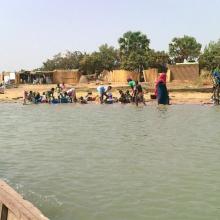
Lac Tchad
- Country:Niger
- Site number:1072
- Area:338,550 ha
- Designation date:17-06-2001
- Coordinates:14°01'N 13°18'E
Materials presented on this website, particularly maps and territorial information, are as-is and as-available based on available data and do not imply the expression of any opinion whatsoever on the part of the Secretariat of the Ramsar Convention concerning the legal status of any country, territory, city or area, or of its authorities, or concerning the delimitation of its frontiers or boundaries.
Overview
The Site covers the Nigerien part of Lake Chad, which is shared with Cameroon, Chad, and Nigeria. Though much reduced in recent years, the Lake is still the fourth largest in Africa after Lakes Victoria, Tanganyika, and Nyassa, and apparently the third largest endorheic lake in the world (after the Aral and Caspian Seas). The shallow lake is fed principally by the rivers which flow from the different countries and to a lesser extent (10%) by rainwater. The Nigerien portion is extremely biodiverse, with many migratory birds but also 120 species of fish. The rich bird life includes the Northern pintail (Anas acuta), garganey (Anas querquedula), gull-billed tern (Gelochelidon nilotica), reed cormorant (Microcarbo africanus), ruff (Philomachus pugnax) and marabou stork (Leptoptilos crumenifer). In this arid or semi-arid environment, the supply of water depends upon the rainfall across the wider catchment, which fluctuates and has generally not been favourable in recent years. Fish catches have declined significantly in recent decades despite very recent positive trends. Traditional nomadic livestock practices could contribute to desertification and require improved management.
Administrative region:
Diffa
- Last publication date:13-04-2018
